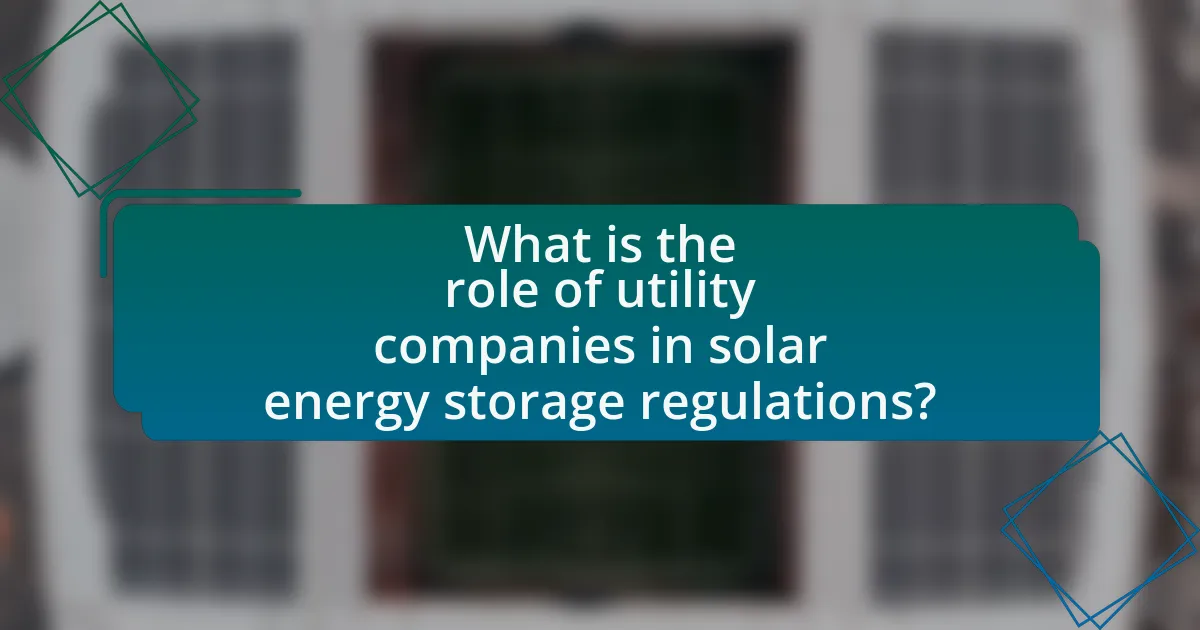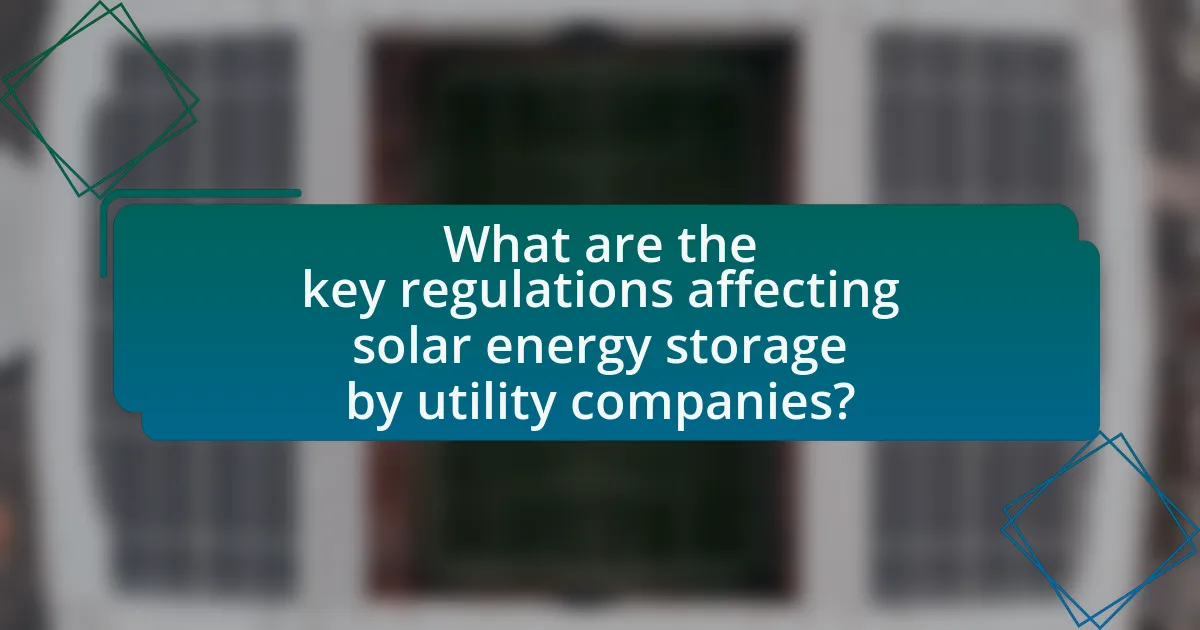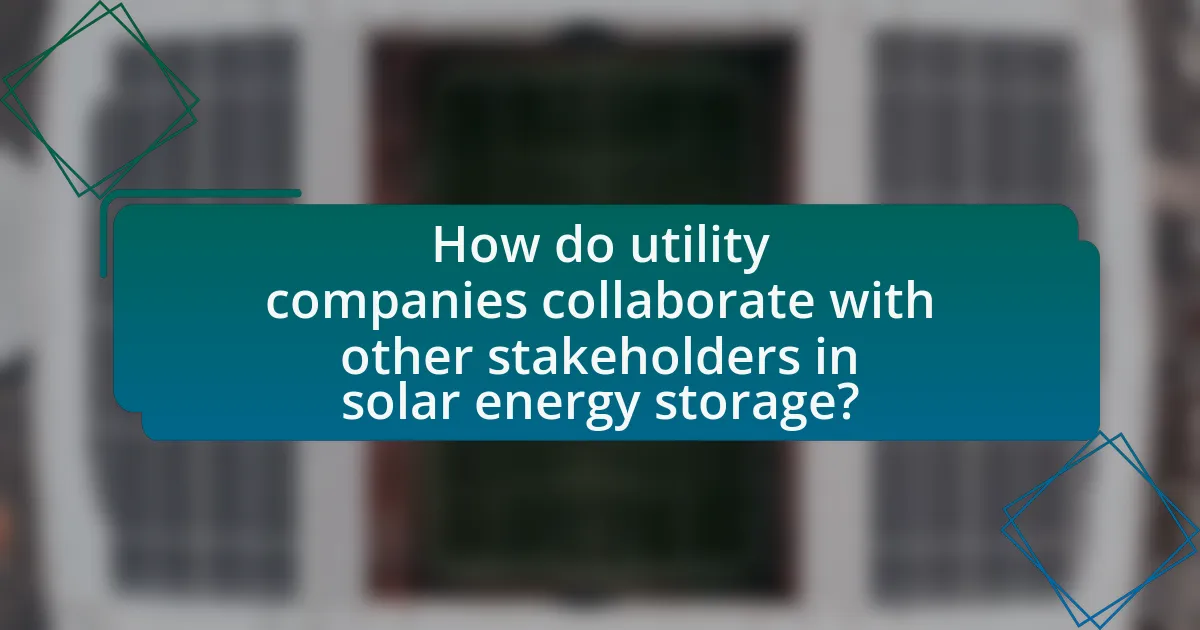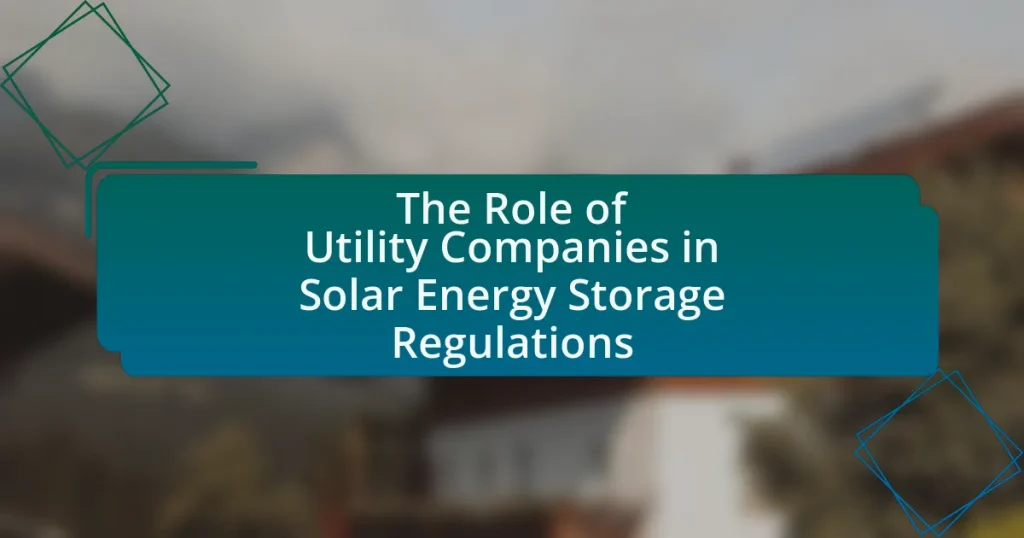Utility companies are pivotal in shaping solar energy storage regulations, as they establish guidelines for integrating solar systems with storage technologies while ensuring grid reliability. This article examines how utility companies influence solar energy storage policies through regulatory lobbying, incentive programs, and the establishment of safety and performance standards. It also discusses the challenges these companies face in integrating solar energy storage, the impact of federal and state regulations on their practices, and the implications for consumers. Additionally, the article highlights the importance of collaboration between utility companies and other stakeholders, including solar energy providers and non-profit organizations, in advancing solar energy storage solutions.
What is the role of utility companies in solar energy storage regulations?


Utility companies play a crucial role in solar energy storage regulations by establishing guidelines that govern the integration of solar energy systems with storage technologies. These companies are responsible for ensuring grid reliability and managing the flow of electricity, which necessitates regulations that dictate how solar energy can be stored and utilized. For instance, utility companies often set standards for interconnection, safety, and performance of energy storage systems, which are essential for maintaining grid stability. Additionally, they may implement incentive programs that encourage the adoption of solar storage solutions, thereby influencing market dynamics and consumer behavior.
How do utility companies influence solar energy storage policies?
Utility companies influence solar energy storage policies primarily through regulatory lobbying and the establishment of incentive programs. By engaging with policymakers, utility companies can advocate for regulations that favor their operational interests, such as net metering rules and interconnection standards that impact how solar energy systems are integrated into the grid. For example, in California, utility companies have played a significant role in shaping the state’s solar energy policies, including the implementation of the Self-Generation Incentive Program, which provides financial incentives for energy storage systems. This demonstrates how utility companies can directly affect the adoption and development of solar energy storage technologies through their influence on policy frameworks and financial incentives.
What specific regulations do utility companies advocate for in solar energy storage?
Utility companies advocate for regulations that ensure the safe interconnection of solar energy storage systems to the grid, establish performance standards for energy storage technologies, and promote incentives for energy storage deployment. These regulations are essential for maintaining grid reliability and safety while facilitating the integration of renewable energy sources. For instance, the National Electric Code (NEC) provides guidelines for the installation of energy storage systems, ensuring they meet safety standards. Additionally, utility companies often support policies that allow for net metering and demand response programs, which incentivize customers to utilize energy storage effectively, thereby enhancing grid stability and efficiency.
How do these regulations impact solar energy storage systems?
Regulations significantly impact solar energy storage systems by defining operational standards, financial incentives, and interconnection requirements. These regulations can facilitate or hinder the deployment of storage technologies by establishing guidelines for safety, efficiency, and integration with the grid. For instance, regulations that promote net metering allow solar energy storage systems to store excess energy for later use, enhancing their economic viability. Additionally, policies such as the Investment Tax Credit (ITC) provide financial incentives that encourage investment in solar storage solutions, thereby increasing their adoption.
Why are utility companies important in the transition to solar energy?
Utility companies are crucial in the transition to solar energy because they manage the integration of solar power into the existing energy grid. Their role includes ensuring grid stability, facilitating the interconnection of solar installations, and providing necessary infrastructure for energy distribution. For instance, according to the U.S. Energy Information Administration, utility companies are responsible for maintaining the reliability of the grid, which is essential as more solar energy sources are added. Additionally, they often implement net metering policies that allow solar energy producers to sell excess energy back to the grid, incentivizing solar adoption.
What challenges do utility companies face in integrating solar energy storage?
Utility companies face several challenges in integrating solar energy storage, primarily related to regulatory frameworks, infrastructure compatibility, and financial investment. Regulatory frameworks often lack clarity and consistency, making it difficult for utility companies to navigate the legal landscape surrounding solar energy storage. Infrastructure compatibility poses another challenge, as existing grid systems may not be designed to accommodate the variable nature of solar energy and its storage solutions. Additionally, the financial investment required for integrating advanced storage technologies can be substantial, leading to concerns about return on investment and long-term sustainability. These challenges are compounded by the need for skilled workforce training and public acceptance of new technologies.
How do utility companies balance traditional energy sources with solar energy storage?
Utility companies balance traditional energy sources with solar energy storage by integrating solar power into their energy mix while managing grid stability and demand. They achieve this through advanced grid management technologies, such as smart grids, which allow for real-time monitoring and control of energy flows. Additionally, utility companies utilize energy storage systems to store excess solar energy generated during peak sunlight hours, which can then be released during periods of high demand or low solar generation. This approach not only enhances the reliability of the energy supply but also helps in reducing reliance on fossil fuels. According to the U.S. Energy Information Administration, as of 2022, about 20% of the electricity generated in the U.S. came from renewable sources, including solar, indicating a significant shift towards integrating solar energy into the traditional energy framework.
What are the key regulations affecting solar energy storage by utility companies?


Key regulations affecting solar energy storage by utility companies include the Federal Energy Regulatory Commission (FERC) Order 841, which mandates that utilities allow energy storage systems to participate in wholesale electricity markets. Additionally, state-level regulations, such as California’s Assembly Bill 2514, require utilities to procure energy storage resources to enhance grid reliability. These regulations aim to facilitate the integration of renewable energy sources, improve grid resilience, and promote energy storage technologies.
How do federal and state regulations shape utility company practices?
Federal and state regulations significantly shape utility company practices by establishing guidelines for energy production, distribution, and pricing. These regulations ensure compliance with environmental standards, promote renewable energy integration, and protect consumer interests. For instance, the Federal Energy Regulatory Commission (FERC) oversees interstate electricity sales and transmission, while state public utility commissions regulate local utility rates and service quality. Additionally, state mandates for renewable portfolio standards require utilities to obtain a certain percentage of energy from renewable sources, influencing their investment strategies and operational decisions. This regulatory framework drives utility companies to adapt their practices to meet both compliance requirements and market demands for sustainable energy solutions.
What role does the Federal Energy Regulatory Commission play in solar energy storage regulations?
The Federal Energy Regulatory Commission (FERC) regulates the interstate transmission of electricity, including aspects related to solar energy storage. FERC’s role involves establishing policies that facilitate the integration of energy storage systems into the grid, ensuring that these systems can participate in wholesale electricity markets. For instance, FERC Order No. 841, issued in 2018, mandates that regional transmission organizations and independent system operators remove barriers to the participation of energy storage resources in their markets, thereby promoting competition and efficiency. This regulatory framework supports the growth of solar energy storage by enabling better access to market opportunities for storage providers.
How do state-level policies differ in their approach to solar energy storage?
State-level policies differ significantly in their approach to solar energy storage, with variations in incentives, regulations, and integration with the grid. For instance, California has implemented aggressive incentives for energy storage systems, including the Self-Generation Incentive Program, which provides financial support for residential and commercial storage installations. In contrast, Texas focuses on market-driven approaches, allowing energy storage to participate in competitive electricity markets without extensive regulatory frameworks. Additionally, states like New York have established specific targets for energy storage deployment, aiming for 3,000 megawatts by 2030, while others may lack such ambitious goals. These differences reflect each state’s energy needs, regulatory environments, and commitment to renewable energy integration.
What are the implications of these regulations for consumers?
The implications of these regulations for consumers include enhanced access to solar energy storage solutions and potential cost savings on energy bills. By regulating utility companies, consumers may benefit from improved incentives for adopting solar technologies, such as rebates or tax credits, which can lower the initial investment costs. Additionally, regulations may ensure fair pricing structures for energy storage systems, allowing consumers to store excess energy generated from their solar panels and use it during peak demand times, ultimately reducing reliance on grid electricity. Studies indicate that states with supportive regulations have seen increased adoption rates of solar energy, leading to lower overall energy costs for consumers.
How do regulations affect the cost of solar energy storage for consumers?
Regulations significantly impact the cost of solar energy storage for consumers by influencing installation, operational, and maintenance expenses. For instance, government incentives and rebates can lower upfront costs, making solar storage systems more accessible. Conversely, stringent regulations may impose additional compliance costs on manufacturers and installers, which can be passed on to consumers. According to the National Renewable Energy Laboratory, regulatory frameworks can account for up to 30% of the total cost of solar energy systems, highlighting the direct correlation between regulatory policies and consumer pricing.
What consumer protections are in place regarding solar energy storage regulations?
Consumer protections regarding solar energy storage regulations include warranty requirements, performance guarantees, and disclosure obligations imposed on manufacturers and installers. These regulations ensure that consumers receive reliable products and services, protecting them from potential financial losses due to faulty equipment or inadequate performance. For instance, many states mandate that solar energy storage systems come with warranties that cover defects and performance for a specified period, often ranging from 5 to 25 years. Additionally, regulations may require installers to provide clear information about system capabilities, costs, and potential savings, enabling consumers to make informed decisions. These protections are designed to enhance consumer confidence and promote fair practices within the solar energy market.
How do utility companies collaborate with other stakeholders in solar energy storage?


Utility companies collaborate with other stakeholders in solar energy storage through partnerships, regulatory frameworks, and technology sharing. These collaborations often involve local governments, private sector companies, and research institutions to enhance the efficiency and reliability of solar energy systems. For instance, utility companies may engage in joint projects with technology firms to develop advanced energy storage solutions, thereby improving grid stability and integrating renewable energy sources. Additionally, regulatory bodies often facilitate these collaborations by establishing guidelines that promote shared investments and risk management strategies, ensuring that all parties benefit from the advancements in solar energy storage.
What partnerships exist between utility companies and solar energy providers?
Utility companies often partner with solar energy providers to enhance renewable energy integration and improve grid reliability. These partnerships typically involve power purchase agreements (PPAs), where utility companies agree to buy electricity generated by solar facilities at predetermined rates, facilitating financial stability for solar developers. For example, in California, Pacific Gas and Electric has entered into multiple PPAs with solar providers to meet state-mandated renewable energy targets, demonstrating a commitment to increasing solar capacity. Additionally, some utilities collaborate with solar companies on community solar projects, allowing customers to invest in shared solar installations, which broadens access to solar energy. These collaborations not only support the growth of solar energy but also help utilities manage peak demand and reduce greenhouse gas emissions.
How do these partnerships enhance solar energy storage solutions?
Partnerships between utility companies and solar energy providers enhance solar energy storage solutions by facilitating the integration of advanced technologies and optimizing energy management. These collaborations often lead to the development of innovative storage systems that can store excess solar energy for later use, thereby improving grid reliability and efficiency. For instance, utility companies can leverage their infrastructure and expertise to implement large-scale battery storage projects, which can significantly increase the capacity to store renewable energy. Additionally, partnerships can enable better demand response strategies, allowing for more effective balancing of supply and demand, ultimately leading to reduced energy costs and increased adoption of solar technologies.
What role do non-profit organizations play in this collaboration?
Non-profit organizations play a crucial role in the collaboration between stakeholders in solar energy storage regulations by advocating for sustainable practices and representing community interests. They often facilitate dialogue among utility companies, government agencies, and the public, ensuring that diverse perspectives are considered in regulatory frameworks. For instance, organizations like the Solar Energy Industries Association (SEIA) provide research, policy recommendations, and educational resources that help shape effective regulations. Their involvement is essential for promoting transparency and accountability in the regulatory process, ultimately leading to more equitable and environmentally sound energy solutions.
How do utility companies engage with regulatory bodies and the public?
Utility companies engage with regulatory bodies and the public through structured communication, public hearings, and stakeholder meetings. These interactions are essential for ensuring compliance with regulations and addressing community concerns. For instance, utility companies often participate in regulatory proceedings to discuss rate changes, service reliability, and renewable energy initiatives, which allows them to present their perspectives and gather feedback. Additionally, they conduct outreach programs to educate the public about solar energy storage options and their benefits, fostering transparency and trust. This engagement is supported by regulatory frameworks that mandate public participation in decision-making processes, ensuring that utility companies remain accountable to both regulators and the communities they serve.
What strategies do utility companies use to communicate regulatory changes?
Utility companies employ multiple strategies to communicate regulatory changes, including direct customer notifications, public meetings, and digital platforms. Direct customer notifications often involve sending letters or emails to inform customers about changes that may affect their services or rates. Public meetings provide a forum for stakeholders to discuss regulatory changes and gather feedback, ensuring transparency and community engagement. Digital platforms, such as websites and social media, are utilized to disseminate information quickly and reach a broader audience, allowing for real-time updates and interactive communication. These strategies are essential for maintaining compliance and fostering trust between utility companies and their customers.
How can public feedback influence utility company regulations on solar energy storage?
Public feedback can significantly influence utility company regulations on solar energy storage by providing insights into consumer needs and preferences. When utility companies receive feedback from the public, they can identify gaps in service, understand community concerns, and adapt their policies to better align with customer expectations. For instance, public input can lead to the development of more favorable net metering policies or incentives for solar energy storage systems, as seen in states like California, where consumer advocacy has shaped regulatory frameworks. This feedback loop ensures that regulations are not only technically sound but also socially acceptable, ultimately fostering a more sustainable energy landscape.
What best practices should utility companies follow in solar energy storage regulations?
Utility companies should implement transparent interconnection processes as a best practice in solar energy storage regulations. This involves establishing clear guidelines for connecting solar energy storage systems to the grid, which can enhance reliability and safety. Additionally, utility companies should adopt standardized performance metrics to evaluate energy storage systems, ensuring consistent assessment and integration into the energy mix. Furthermore, engaging stakeholders, including customers and regulators, in the development of policies fosters collaboration and addresses community needs. Evidence from the National Renewable Energy Laboratory indicates that streamlined interconnection processes can reduce costs and installation times, thereby promoting the adoption of solar energy storage solutions.


